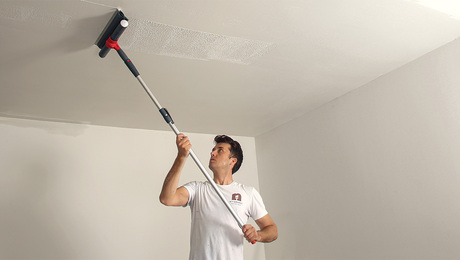*
The epoxy product that I have used (Abatron) is worth the extra if for no other reason that it sands more like the wood, whereas Bondo is much harder than the wood and will tend to stand proud of the surrounding areas if you’re not careful when sanding. I’m not familiar with the P.C. product to which you refer, but would never mix products that use different solvents.
Discussion Forum
Discussion Forum
Up Next
Video Shorts
Featured Story

Skim-coating with joint compound covers texture, renews old drywall and plaster, and leaves smooth surfaces ready to paint.
Highlights
"I have learned so much thanks to the searchable articles on the FHB website. I can confidently say that I expect to be a life-long subscriber." - M.K.














Replies
*
The epoxy product that I have used (Abatron) is worth the extra if for no other reason that it sands more like the wood, whereas Bondo is much harder than the wood and will tend to stand proud of the surrounding areas if you're not careful when sanding. I'm not familiar with the P.C. product to which you refer, but would never mix products that use different solvents.
*
Following a previous discussion on this forum I tried Bondo on a refinishing project. It didn't take finish the same as the wood so to my eye it stands out. Admittedly the casual observer probably won't see the difference.
Also, like the previous poster I had to take care to sand it in properly.
On the plus side, it was CHEAP. So, for quality work I probably won't use it again. But if it is in an area where appearance doesn't count I will.
*I've had good results for small repairs with the Minwax (TM) wood filler which according to a back FHB article is a polyester not an epoxy. I understand it's the same composition as Bondo packaged in small/retail expensive batches. Same observations about sanding. I've usually tried to take down the highest spots with a SHARP paring chisel and sanded only to finish. It takes paint very well but would stand out if only stained.Perhaps most interesting to you is that Minwax makes a compatible liquid consolidant. Don't know that it fills pores and structurally hardens the soft material like Abatron is supposed to. I do know that wood decay fungi will survive in surrounding areas and decay may progress beyond the repaired area (at least in poplar in exterior applications, which admittedly is a poor choice). But it gives you a compatible material to experiment with.
*
bondo works great for interior paint-grade applications, but i'd use epoxy for anything that will see the abuses of weather.
*Have used Bondo in many interior and exterior applications without problem. The trick is not to put it on too thick (build up layers or use blocks of wood to fill voids), and to sand/trim while the material is still plastic (within 30 minutes of application). A good primer applied before painting, and the repair is almost undetectable.
*
I have to agree with bullet. Worked on a project in Brooklyn replacing all the sash in an old hotel. Many sashes had bondo repairs, and the wood either separated from the patch, or rotted away around it.
We used Abatron products with great results. They not only have fillers, but also a product called Liquid Wood that you impregnate the old wood with, rotted or not, and it stabilizes it. You can check out this product, as well as Wood Epox at http://www.abatron.com/home002.htm
So, if it were my job, I'd go the extra mile. Your clients will be happier a few years down the road.
Have fun.
*One thing mentioned the last time this came up is that the Abatron products, and another I can't remebemr the name of, are suposed to be compatible with wood movement; you know the bondo isn't. i don't know if that is true or not, I've never seen it in the Abatron literature. Anyway, I stick to a basic set of rules : bondo for interior filling (like norml said, do your carving and shaping before it sets). Abatron for exterior stuff requiring consolidation, usually Abatron putty after for filling voids. Anything structural and exterior, West System epoxy, and an assortment of phenolic microballoons and other fillers. I just figure any dollars I save in materials, I will pay many times over in rework if something fails.
*
I have some extensive window repairs on
one or two sashes at a job I am working
on. Is epoxy worth the extra money?
Does anyone know how both materials hold
up over time. Also, can I use a
consolidant like the water based P.C
Epoxy stuff with a bondo type filler.
Let me know what you know. Thanks in
advance.